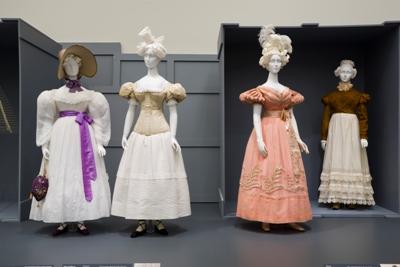Since the opening of Fashioning Fashion: European Dress in Detail, 1700–1915, the Costume and Textiles Department has received many requests to share how we created the paper wigs seen on the exhibition mannequins. The process of hand-crafting the wigs began nine months before the opening of the show as the curators were finalizing their exhibition checklist of fashionable dress and deciding on display methods. While we were very excited to share the fantastic new collection of European clothing with the public, secondary details such as hairstyles and accessories were essential to shaping a stylish, historically correct presentation.

Fashioning Fashion, installation view
In order to accurately recreate hairstyles of the past, we looked at portraits, fashion plates, and photographs corresponding to the historical periods of each ensemble. Factors such as the purpose of the clothing (e.g., court dress, at-home dressing gown) and if the mannequin would be wearing a hat were considered.

An example of the research we used to determine hairstyles for the ensembles. Le Bon Ton, no.868, August 1901, Doris Stein Research Center

Dress, France, c. 1900, purchased with funds provided by Suzanne A. Saperstein and Michael and Ellen Michelson, with additional funding from the Costume Council, the Edgerton Foundation, Gail and Gerald Oppenheimer, Maureen H. Shapiro, Grace Tsao, and Lenore and Richard Wayne

Fibre rush, starched buckram, curling iron, and hot glue gun were used to create the wigs.

The buckram was softened with warm water...

...and stretched over a hat block and left to dry into a stiff form.

Once dry, the molded buckram was removed from the form and trimmed into a cap. The cap was the base for building the hairstyle.

Fibre rush, a paper product used in chair caning, was used to create the actual “hair.”

The fibre rush was flattened and cut into narrow strips, then hot glued onto the outside of the buckram cap.

The paper strips were wound around curling irons and pencils to produce curls of various sizes.

The paper strips were manipulated into knots, buns, braids, and waves.

Some of the wigs were filled with padding to maintain their shapes. Ribbons and feathers were added as finishing touches.

Once the wig was completed, it was placed on the mannequin’s head for final adjustments. Et voilà!
Sophia Gan, Installation Assistant, Costume and Textiles



